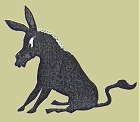|
Gjirokastra
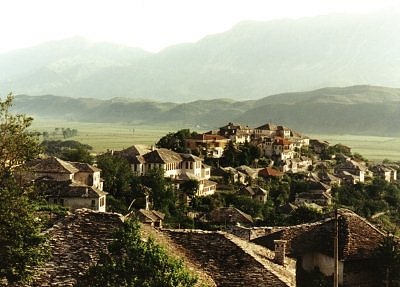
Photo by Anthony Weir
Gjirokastra
or GJIROKASTĖR is one of the most venerable towns
of Albania. Its name means Silver Fortress, and neatly shows
the relation within one linguistic group of Greek, Latin, Etruscan
and Albanian.Like Berat to the north, it is a UNESCO World Heritage
City.
In the south
of the country, 300 meters above sea level, Gjirokastra has a beautiful
and dramatic situation in a lush valley between the high Gjerė mountains
and the rushing river Drin or Drinos.
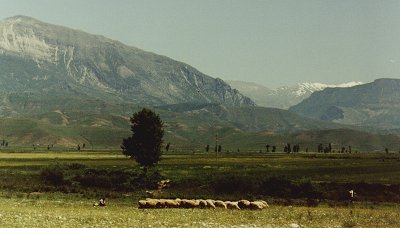
Photos by Anthony Weir

Note the ubiquitous Hoxha-bunkers built all
over Albania at huge cost
following the Soviet invasion of Czechoslovakia in 1998.
It is dominated
by an Ottoman fortress said to be the second largest in the Balkans,
the largest being in Belgrade. Its important and commanding situation
(guarding one of the main North-South routes of the Balkans) indicates
that it must have been since prehistoric times the site of a fort
or fortress. Crusaders passed by, looting and raping and pillaging,
in the 11th century.
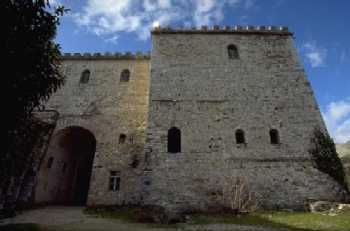
A charming
recent legend recounts that when Ottomans invaded in the 14th century
a Princess Argyro jumped from the highest tower of the castle of
Gjirokastėr with her very young son, to escape seizure by the Turks.
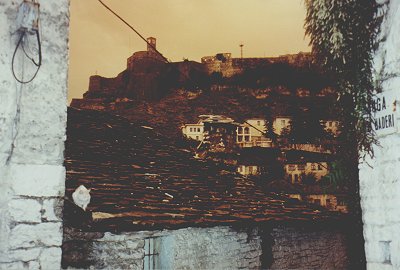
Photo by Anthony Weir
The old part
of the town, with charming and characteristic Balkan-Ottoman houses,
many with rooves composed of expertly-cut shale stone, surrounds
the citadel and overlook the grim Communist-built slum-suburbs and
the flood-plain of the Drin.
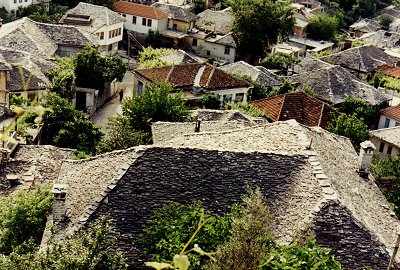
Photos by Anthony Weir
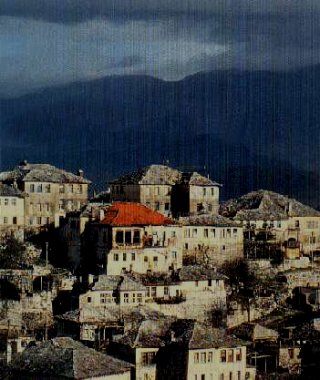
The old residential quarter under one of the many sudden rainstorms
in the Drinos valley.
The old Ottoman houses do
not have balconies, but they are richly endowed with well-proportioned
windows. Many have elegant verandas. The narrow streets have very
well-laid cobble-stones and square-sets. The corner-houses have
windows which are vantage-points, as can be seen in the picture
below.
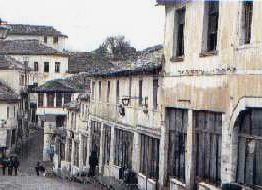
One of the main streets (the
former Bazaar) of the old town taken just after the Communist period.
Beyond the
core of the town below the citadel, the houses are obviously residential
- a few of them almost palatial. These date from the period in the
middle of the 19th century when Albania was a wealthy part of the
Ottoman Empire, to which the country supplied not only fearsome
administrators such as the notorious Ali Pasha of Tepelena, but
engineers and architects. Berat to the North has similar buildings
also surrounding a citadel.
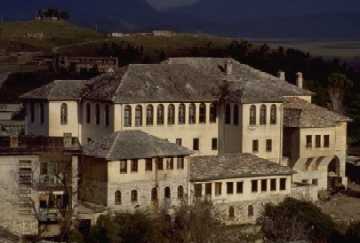
Gjirokastra
(much of whose population spoke Greek, just as much of the population
of Iannina in northwestern Greece spoke Albanian) played an important
role in the early Albanian liberation movement. The Assembly
of Gjirokastra was held in July 1880. Vlachs also were a significant
minority in Southern Albania.
With the rest
of Albania, Gjirokastėr was occupied by Mussolini's forces in 1938,
then by the Greeks after Italy's pathetic attack on Greece in 1940
- then by the Italians again, and finally by the Germans after the
Italian surrender to the Allies. This period and earlier is covered
by Ismail Kadare's Chronicle of Stone (which has been
badly translated into English). Both Hoxha (whose name means mullah,
and is pronounced 'hodja') and Kadare were born in the town.
Like Yugoslavia,
Albania was liberated from the Germans by groups headed by a Communist
guerrilla leader who quickly controlled the whole country. But Tito
was a much more subtle and pragmatic leader than Hoxha - who was
born in Gjirokastra, and whose name means 'mullah'. Hoxha quite
quickly became paranoid (not least because Tito nearly succeeded
in annexing Albania as a province of Yugoslavia) - to Albania's
continuing cost.
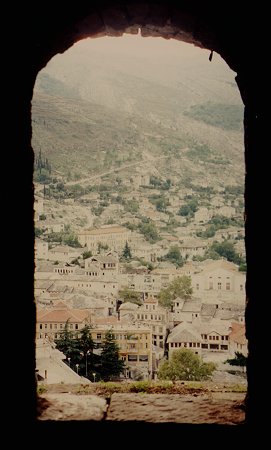
View of the town from
the citadel.
Photo by
Anthony Weir
Under Comrade Enver Hoxha the Fortress of Gjirokastėr with its 7
towers, remodelled by Ali Pasha of Tepelena in 1811-12 (now in some
state of disrepair due to looting and vandalism), became not only
a prison (the cells for political prisoners still to be seen at
the top) but the scene of a biennial Folk Festival - last held in
1988. This attracted performers from neighboring countries, and
musicologists from at least as far as Britain. Some fine recordings
of this last festival survive in archives.
Under Hoxha
the National Museum of Arms was established in the ground floor
of the fortress. It was looted during the first wave of unrest in
1990. The remains of an ancient American spy-plane, shot down in
the 1950s, are to be seen in the main yard of the monument.
Ali Pasha
also constructed an aqueduct 10 km (over 6 miles) long, to bring
in 28,000 gallons of drinking water a day from Mount Sopot. It was
demolished in 1932 under the régime (1925-39) of President (from
1928, King) Zog - whose name, curiously, means 'bird' - and its
stones used as building material.
Approaching
Gjirokastra from the south (the only road runs north along the river
valley) and about a kilometer from the lower town is a fine stone
bridge over the Drin, built early in the Ottoman period.
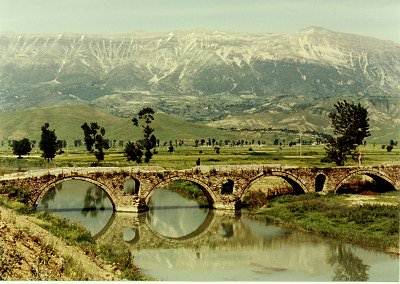
Photo
by Anthony Weir
|
